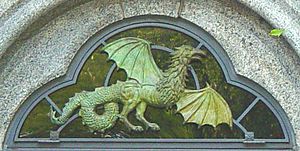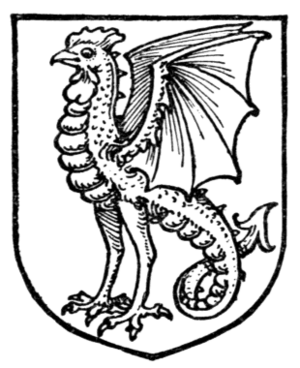Cockatrice facts for kids
A cockatrice is a mythical creature from old stories. Imagine a two-legged dragon or snake with the head of a rooster! These amazing beasts were very popular in English myths and plays for hundreds of years. People believed they were real and had special powers.
What is a Cockatrice?
How it Started
The idea of the cockatrice as we know it first appeared around the late 1300s. People often confused it with another mythical creature called a basilisk. A basilisk usually looks like a snake or lizard without wings. But the cockatrice always has a rooster's head and often wings.
Many old legends say that a cockatrice hatches from an egg laid by a male chicken (a cock). This special egg then needs to be kept warm by a toad. Sometimes, the stories say a snake might hatch the egg instead. People even believed you could stop a cockatrice from hatching! You just had to throw the egg over your house so it landed on the other side, without hitting the house itself.
Amazing Powers
The cockatrice was thought to have some truly scary powers. It could kill people in several ways:
- With its eyes: Just one look from a cockatrice was said to be deadly.
- By touching: If it touched you, it could also kill you.
- With its breath: Sometimes, even its breath was believed to be poisonous.
But there were also ways to defeat this creature!
- The weasel was believed to be the only animal that could survive a cockatrice's deadly stare.
- A cockatrice would instantly die if it heard a rooster crow.
- One of the best ways to kill a cockatrice was to make it look at itself in a mirror. It would then die from its own deadly gaze!
Cockatrice in Symbols
The cockatrice is sometimes used in heraldry. Heraldry is the study of special symbols and designs, like those on family coats of arms or flags. In heraldry, the cockatrice looks a lot like a wyvern (a type of dragon with two legs). The main difference is its rooster head.
Often, the cockatrice in these symbols has a comb, wattles (the fleshy bits under a rooster's beak), and a beak that are a different color from the rest of its body.
The cockatrice was the special symbol for the Langley family in England way back in the 1300s. It is also the symbol for the 3 (Fighter) Squadron of the Royal Air Force, which is the air force of the United Kingdom.
See also
 In Spanish: Cocatriz para niños
In Spanish: Cocatriz para niños



